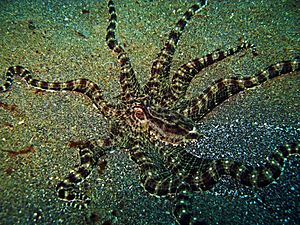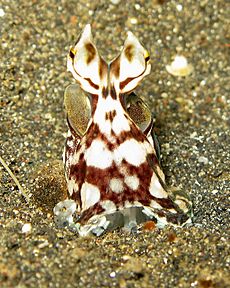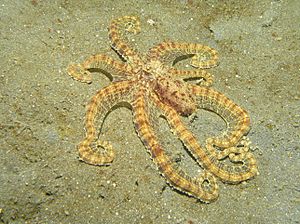Mimic octopus facts for kids
Quick facts for kids Mimic octopus |
|
|---|---|
 |
|
| Scientific classification | |
| Kingdom: | |
| Phylum: | |
| Class: | |
| Order: | |
| Family: |
Octopodidae
|
| Genus: |
Thaumoctopus
Norman & Hochberg, 2005
|
| Species: |
T. mimicus
|
| Binomial name | |
| Thaumoctopus mimicus (Norman & Hochberg, 2005)
|
|
The mimic octopus is a truly amazing sea creature! It's famous for its incredible ability to copy the look and actions of other animals. This special skill helps it survive in the ocean.
Scientists first found this octopus in 1998 near Sulawesi, Indonesia. It was living on a muddy river bottom. For a while, people thought it only lived in the western and central Indo-Pacific region. But then, in 2012, one was seen near the Great Barrier Reef in Australia!
This octopus is not very big. It grows to about 60 centimeters (2 feet) long, including its arms. That's roughly the length of a school ruler. It has small "horns" that stick out above each eye.
Its natural color is light brown or beige. But when it wants to scare off danger, it changes! It often turns a striking white and brown striped pattern. This helps it pretend to be poisonous or mean sea creatures. Its amazing ability to change shape is why it's called the "mimic" octopus.
Contents
How the Mimic Octopus Acts
The mimic octopus moves by shooting water through a special tube called a funnel. This helps it glide over the sand. It's usually looking for food like small fish, crabs, and worms.
This octopus is very clever. It uses its mimicking skills to hunt too! For example, it might pretend to be a crab. When another crab comes looking for a mate, the octopus quickly catches it for dinner.
Unlike many other octopuses, the mimic octopus likes to live in river mouths and estuaries. These are places where rivers meet the sea. Other octopuses often prefer reefs for shelter. But because the mimic octopus can pretend to be dangerous animals, it's safer in open areas.
Mimicry is a common way for animals to survive. Some flies, for instance, have yellow and black stripes like bees. This makes predators think twice before attacking. But the mimic octopus is special. It's the first known animal that can copy more than one other species. It's also the first octopus known to have this amazing ability.
Scientists don't know exactly how many animals the mimic octopus can imitate. But many of the animals it copies are poisonous or dangerous. Here are some of the animals it often pretends to be:
Copying Other Sea Creatures
- Lionfish: These fish are venomous and have brown and white stripes. They also have long, spiny fins. The octopus changes its color and shapes its eight arms to look like these spines. This makes predators think it's a dangerous lionfish to avoid.
- Sea Snake: The octopus can wave two of its arms in opposite directions. It also shows yellow and black markings. This makes it look just like a venomous sea snake.
- Flatfish: To mimic a flatfish, the octopus pulls its arms together on one side. Then it flattens its body and moves along the ocean floor. This makes it look like a harmless flatfish swimming by.
- Jellyfish: Sometimes, the mimic octopus will puff up its head and siphon. It lets its arms trail behind it. Then, it swims to the surface and slowly sinks, spreading its arms out. Many animals that hunt octopuses avoid jellyfish, so this trick works well!
This ability to copy other creatures is super important for the mimic octopus. Almost every sea creature that eats other animals could be a danger to it. So, being able to pretend to be something else helps it stay safe.
Smart Survival Tactics
Scientists have seen the mimic octopus copy up to 15 different marine animals. For example, they studied how it copied a common flounder. They watched nearly 500 times! The octopuses copied the flounder's shape, how it swam, its speed, and even its colors.
When the octopus was mimicking a flounder, it was moving and easy to see. But right before and after, it would hide. It would camouflage itself and stay very still. It would look like small sponges or other objects on the sandy seafloor.
The main discovery was that octopuses only mimicked the flounder when they needed to move. Moving would normally give away their camouflage in the open sand. So, they used mimicry as their main way to defend themselves.
This amazing behavior wasn't known for many years. This is because the muddy areas where the octopus lives weren't studied much. But it's exactly in these open, barren places that this special behavior helps the octopus survive.
The octopus can even choose which animal to mimic based on the danger it faces. For example, if a damselfish attacks it, the octopus might pretend to be a black and yellow banded sea snake. Sea snakes are known predators of damselfish. This shows the octopus can decide the best way to fool its enemy. Like other cephalopods, it can also change its skin to blend in with its surroundings.
What the Mimic Octopus Eats
The mimic octopus can be called both a hunter and a forager. It's a hunter because scientists have seen it stalk and catch small fish. But more often, it forages for food.
It uses a jet of water from its siphon to glide over the sand. It also uses its long, thin arms to reach into cracks in coral and holes in the sand. Then, it uses its suction cups to grab small crustaceans and eat them.
Since the mimic octopus prefers shallow, murky waters, its diet mostly includes small fish and crustaceans. These are the most common animals it can find and eat in those conditions. Mimic octopuses are carnivores, meaning they eat meat. They are not known to eat any plants.
The mimic octopus is different from another famous octopus called the Wunderpus photogenicus. The Wunderpus has white markings that don't change.
Where the Mimic Octopus Lives
The mimic octopus lives in the Indo-Pacific region. This area stretches from the Red Sea in the west to New Caledonia in the east. It goes from the Gulf of Thailand and the Philippines in the north to the Great Barrier Reef in the south. Most of the times it has been seen are in Indonesia.
It mostly lives in sandy or silty areas. It prefers depths of less than 15 meters (49 feet). It likes murky and muddy seafloors. This helps it blend in with its natural brown-beige color.
See also
 In Spanish: Pulpo mimo para niños
In Spanish: Pulpo mimo para niños



